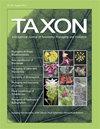The genus problem – Eucalyptus as a model system for minimising taxonomic disruption
IF 2
2区 生物学
Q2 EVOLUTIONARY BIOLOGY
引用次数: 0
Abstract
The ongoing reclassification of higher plant genera (their division, combining and recircumscription) is the cause of extensive modifications to binomials. Many genus reclassifications have been far more taxonomically disruptive than necessary to achieve monophyletic genera. We suggest six rules that should be followed when considering genus reclassifications to minimise any taxonomic disruption and maintain the stability of genus‐species binomials without compromising their scientific validity. Here, we apply these rules to the eucalypts (Myrtaceae), a well‐known group of 840 tree and shrub species that dominate the Australian continent and have worldwide economic importance. Traditionally, most eucalypts have been placed in the genus种属问题--桉树是尽量减少分类混乱的示范系统
高等植物属的不断重新分类(它们的划分、合并和重新归类)是导致二名类广泛修改的原因。许多属的重新分类在分类学上的破坏性远远超过了实现单系属所需的破坏性。我们提出了在考虑属的重新分类时应遵循的六条规则,以尽量减少分类学上的干扰,并在不影响属种二项式的科学性的前提下保持其稳定性。在此,我们将这些规则应用于桉树(桃金娘科),这是一个由 840 个乔木和灌木物种组成的著名类群,在澳大利亚大陆上占主导地位,具有世界性的经济意义。传统上,大多数桉树都被归入桉属。然而,自 1995 年分离属 Corymbia 被描述以来,桉树的属级分类一直处于变动状态,导致 100 多个物种(包括许多著名物种)出现了新的双名。最近,分离属 Blakella 被描述,再次产生了许多新的双名,其中也包括许多广为种植的知名物种。在这里,我们证明了 Brooker 的属级分类与 Hill 和 Johnson 的三属分类以及 Crisp & al.我们还证明,单属分类法将最大程度地减少未来可能出现的属级分类混乱,并在我们继续深入了解类群之间关系的过程中,为处理这一重要植物类群的一系列用户提供最大的分类效用。
本文章由计算机程序翻译,如有差异,请以英文原文为准。
求助全文
约1分钟内获得全文
求助全文
来源期刊

Taxon
生物-进化生物学
CiteScore
4.70
自引率
8.80%
发文量
177
审稿时长
6-12 weeks
期刊介绍:
TAXON is the bi-monthly journal of the International Association for Plant Taxonomy and is devoted to systematic and evolutionary biology with emphasis on plants and fungi. It is published bimonthly by the International Bureau for Plant Taxonomy and Nomenclature, c/o Institute of Botany, Slovak Academy of Sciences, Dúbravská cesta 9, SK-845 23 Bratislava, SLOVAKIA. Details of page charges are given in the Guidelines for authors. Papers will be reviewed by at least two specialists.
 求助内容:
求助内容: 应助结果提醒方式:
应助结果提醒方式:


